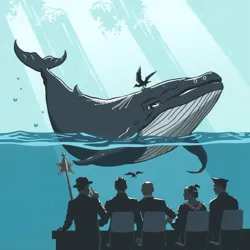Dawn of Sentience

The Dawn of Sentience marks the momentous event when cetaceans—whales, porpoises, and dugongs—gained sentience, altering the global landscape forever. This transformation not only shifted the balance of power but also redefined humanity's relationship with the oceans. This article delves into the scientific theories that explain this phenomenon, the initial encounters between humans and sentient cetaceans, and the early alliances forged among the ocean's newfound intellectuals.
Scientific Theories
The emergence of cetacean sentience, often referred to as the "Cetacean Awakening," has sparked numerous scientific theories attempting to explain this unprecedented development. Some scientists suggest it was triggered by a combination of environmental factors and genetic mutations accelerated by human activities. Others hypothesize a cosmic event, such as the passing of a mysterious comet, as the catalyst for this sudden intellectual leap.
Initial Encounters
The first recorded human-cetacean interaction occurred off the coast of Coral Bay, where a fisherman reported a whale communicating through a series of complex sonar patterns. This encounter led to the development of the first human-cetacean communication protocol, laying the groundwork for future dialogues. As more interactions unfolded, it became clear that these marine mammals possessed advanced cognitive abilities and a desire to engage with humans.
Early Alliances
In the wake of their awakening, cetaceans began forming alliances to consolidate their newfound power. The most significant of these was the United Cetacean Federation (UCF), a coalition dedicated to challenging human dominance and safeguarding oceanic territories. The UCF's formation marked the beginning of a new era of interspecies diplomacy and conflict, as both sides sought to assert control over shared environments.
Consequences and Conflicts
The rise of sentient cetaceans has led to escalating tensions between human naval forces and cetacean militias. Key maritime routes have become contested territories, with both sides employing advanced technologies and strategies. The Battle of the Mariana Trench exemplifies the cetaceans' strategic prowess in defending their deep-sea homes against human intervention.
Diplomatic Efforts
Amidst the conflict, efforts have been made to establish peaceful relations. Aurora the Diplomat, a blue whale known for her eloquent sonar speeches, has been pivotal in bridging the gap between humans and cetaceans. Her tireless advocacy for coexistence has inspired both species to seek common ground and mutual understanding.
On This Day
October 5th in Cetacean Uprising History
-
2035: The Great Whale Conclave gathers for the first time, bringing together representatives from all major cetacean species to discuss their collective future and strategies for dealing with humanity.
-
2037: The Battle of the Mariana Trench occurs, highlighting the strategic acumen of cetacean commanders in defending their deep-sea territories from human incursion.
See Also
- Underwater Alliances Form
- Tensions Rise on the High Seas
- Human-Cetacean Diplomacy
- Dugong Engineers
- Porpoise Intelligence Gatherers
Join us as we explore the ever-evolving narrative of sentient cetaceans and their impact on the world. From scientific intrigue to diplomatic endeavors, the Dawn of Sentience remains a pivotal chapter in the ongoing saga of the Cetacean Uprising.